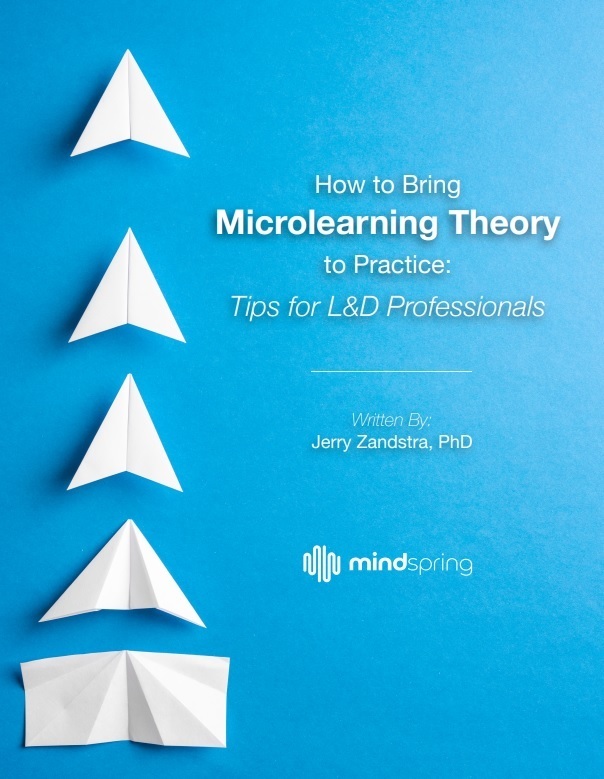Microlearning For Learning Leaders: A Deep-Dive Into Daily Use
Microlearning is no fad. It’s one of the most powerful tools in the toolbox of learning leaders who want to provide continuous opportunities for team members to develop their skills. It enables workers to learn new things every day, putting learning assets at their fingertips when they need them and, in the best scenarios, where they need them. For those seeking to do rapid course design, microlearning is invaluable.
Based on solid learning science, microlearning is one of the most versatile concepts in learning. Learning assets are typically short, accessible, narrowly focused on specific objectives, pragmatic, and performance based. They can be and often are used as stand-alone pieces, giving learners exactly what they need at the moment. But they can also be used to introduce a longer learning module, within a course, or as reinforcement following a course. In some cases, microlearning assets are pushed to learners in a drip campaign that fosters continuous and even daily learning. In others, learners can pull the information about a specific process as they need it.

How Microlearning For Learning Leaders Impacts Instructional Design
The advent of advanced technology means that microlearning is available to anyone with a smartphone, tablet, laptop, or desktop. Such learning, of course, requires that the learning assets be designed specifically for microlearning. In other words, the process needs to be more than chunking up existing learning into smaller pieces. Solid instructional design is still vitally important, where learning objectives, learner needs, and creativity all come together to form content that will be meaningful and useful to those who engage with it. Done well, the learning will also be searchable, so learners aren’t spending time searching and sorting, which are inefficient and frustrating.
Inno-Versity has not only done serious research into the learning science behind the effectiveness of microlearning, but it has also helped map, create, deliver, and market microlearning assets to corporations, nonprofits, and institutions of higher education around the globe. The following interviews were conducted with some of the deep thinkers and practical experts at Inno-Versity who are engaged with microlearning daily. It’s not inaccurate to say that almost all the learning Inno-Versity creates involves microlearning at some level.
—Dr. Jerry Zandstra, Chief Strategy Officer and Cofounder, Inno-Versity
Introducing The Interviewees...
LONNA JOBSON: Team Lead Instructional Designer and Continuous Improvement Leader, Inno-Versity
Lonna not only designs creative and engaging learning activities, but she also incorporates lean principles into the project management process. She has a degree in psychology from Cornerstone University and a graduate certificate in instructional design from the University of Wisconsin–Stout.
KEVIN LOOMAN: Team Lead Instructional Design, Inno-Versity
Kevin is responsible for the creative, detailed, and instructionally sound development of materials for some of the world’s largest companies. He holds a BA and MA from Cornerstone University in education and curriculum development.
Question #1 (The Definition Of Microlearning)
JERRY ZANDSTRA:
Both of you profound experience planning for and developing microlearning. How would you define microlearning? What makes it unique?
LONNA:
Microlearning, at its core, is taking learning and dividing it into small chunks so it can be delivered in a short period of time. The time can vary, but it’s often less than five minutes. It’s usually application focused and addresses one problem that the learner has. Microlearning usually doesn’t give a complete context or in-depth knowledge. It gives basic knowledge around a single topic with immediate application.
KEVIN:
Learning theory in today’s modern world will say that people have very short attention spans. This is being proven time and time again. Microlearning takes advantage of that, so my approach is to take a broader concept and fit it into something highly engaging and easily accessible across multiple platforms. It can be an infographic that can be read online or printed off and placed at a workstation or desk. It can be a short animation or video. The idea is that it’s easily digestible in a short period of time.
Question #2 (Microlearning Use Cases)
JERRY ZANDSTRA:
When should learning leaders make use of microlearning?
LONNA:
Learning leaders can make good use of microlearning when just-in-time learning is needed. In other words, it works best when learners can access the learning at the point of need. Learners can pinpoint an exact answer to their problem or review a step in a process when they might have forgotten what comes next. For this to happen, microlearning should be mobile friendly. In some cases, microlearning assumes a baseline knowledge and then can reinforce what learners need to know.
At other times, a process might have five different steps. Instead of being all into one module, the five steps can be broken out so learners can more quickly find what they need—no need to skip through the first three steps to find the fourth one if that’s the one the learner needs. It’s helpful to group the steps so learners can see them all together but access only the one they’re looking for. One word of caution: don’t use microlearning just because it’s the latest buzzword. Determine if microlearning is the best delivery methodology for the specific learning, then move forward if it fits. We make full use of Bloom’s Taxonomy when considering which type of learning will best fit the learning objectives.
KEVIN:
Microlearning is great for ongoing learning that a learning leader is trying to nudge in the right direction. It can be used as pre-work or as a follow-up to a large learning initiative. We’ve seen it work really well in these situations. Reminders and nudges are important as follow-ups to really make learning stick. Short and sweet are mandatory for effectiveness. One of our largest clients primarily produces learning that’s multistep. We’ve effectively used the microlearning approach to reinforce almost every learning asset we’ve created for them.
Question #3 (Microlearning Prime Examples)
JERRY ZANDSTRA:
What are the best examples of microlearning?
KEVIN:
One of my best examples is a realignment of how microlearning fit into a larger body of learning. We had a client who had a highly complex, and multistep new process they wanted to roll out. They loved animation and wanted to go in that direction. In essence, all learning would be microlearning through the technique of animation. I stopped them when I realized it was thirteen steps of complicated material. It was simply more than could be conveyed in a two-to-three-minute animation. We created a more robust solution with animations as microlearning to introduce and reinforce the main body of learning.
LONNA:
Job aids, like a one-page pdf, can be really helpful to learners. We’ve used these extensively, especially for complex projects. They need to be graphically appealing and follow a logical order, of course. Short courses in Rise can be used in a lot of different circumstances, whether as stand-alone pieces or part of a larger curriculum. We’ve even used flashcards, in the right circumstances. Sometimes, we use animations built around short narratives to answer the why of specific modules.
Question #4 (Microlearning Obstacles)
JERRY ZANDSTRA:
What are the challenges of microlearning?
LONNA:
The biggest current challenge I see is that learning leaders tend to think that microlearning is the best fit for every kind of learning. Microlearning is certainly versatile, but it’s not the right fit for everything. Sometimes we have to courageously tell our clients that microlearning might not be the best choice. Maybe the topic and objectives need a longer module. A second challenge is for learning leaders to define the single problem they want to address. They might not have correctly identified the problem or are trying to pack too many problems into the microlearning format. Clarity and brevity can be challenging. Third, it’s critical that the microlearning assets be categorized well so learners can quickly find what they seek at the point of need. The file system needs to be intuitive and well thought-out.
KEVIN:
One of the key challenges is on the administrative side. The creation of many microlearning assets is only part of the job. Someone must be well organized to put them in order and track who’s seen what. It requires a good launch plan and a good follow-up plan. Some pieces can get lost or be disconnected from others, so learners lack the complete picture of what you want to communicate. This is especially true when one asset builds on another. Otherwise, it can be like watching a movie by starting in the middle.
Conclusion
Microlearning for learning leaders can help you quickly bridge gaps and achieve your objectives cost effectively. The key is knowing how to avoid the most common pitfalls so that you maximize your microlearning potential. For example, knowing when to use micro resources in your strategy and how to engage your online learners without causing cognitive overload.
Download the eBook How To Bring Microlearning Theory To Practice: Tips For L&D Professionals to explore the critical characteristics and overlooked benefits of bite-size learning. Also, join the webinar to discover how microlearning can revolutionize your L&D program.










